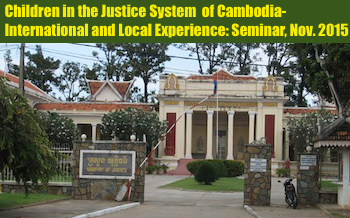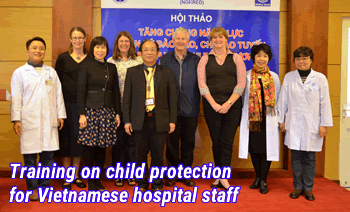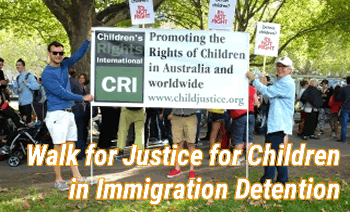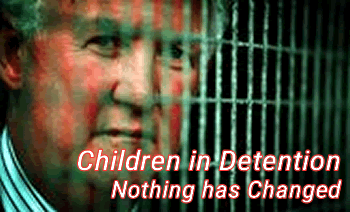RESOLUTIONS
Resolution 1
Member states should be encouraged to examine whether they might decriminalise parental abduction so as to remove any impediment to the prompt return of the child.
Resolution 2
There are provisions in the Brussels II (bis) that are capable of ensuring the return of an abducted child in circumstances where the Hague Convention would not result in such an order. The Hague Conference should be asked to examine whether the provisions of the relevant European regulations could and should be imported into the Hague Abduction Convention or the protocol to same.
Resolution 3
This Congress recognises that it is in the best interests of the child, subject of international abduction, to have return proceedings, and where possible, any further proceedings upon their return, dealt with expeditiously, within 6 weeks of the launch of proceedings, wherever possible. To facilitate such expedition:
a) the Congress calls upon courts to set and adhere to procedural timetables and protocols that ensure the speedy determination of applications, and
b) the Congress supports the concept of judicial communication between network judges.
Resolution 4
Recognizing that the 1996 Hague Convention on the Protection of Children provides an important global system for improving the protection of children in international situations, the Congress urges states that have not already done so to give urgent consideration to ratifying or acceding to the instrument and to put in place an accompanying training programmes for judges, advocates and other relevant professions.
Resolution 5
The recruitment of children as combatants deserves the strongest international condemnation. Further, sanctions should be provided for those who recruit children as combatants and those who knowingly supply weapons to states or individuals who use child combatants.
Resolution 6
The World Congress:
a) encourages the adoption of the ethical practices and principles of the Royal Children’s Hospital, Melbourne, those principles being:
I. minimise physical risk to child;
II. minimise psycho-social risk to child;
III. preserve potential for fertility;
IV. preserve or increase capacity to have satisfying sexual relations;
V. leave options open for the future; and
VI. consider the wishes and beliefs of the parents.
b) notes the debate as to whether issues of disorders of sexual development should be left to the time when the child attains Gillick competence, even in terms of therapeutic intervention.
Resolution 7
The Congress notes the request to the Board to continue the relationship between pediatricians and the Congress.
Resolution 8
That a committee be formed for the purpose of advising and reporting to Children’s Rights International.
Resolution 9
The Congress supports exploring the recognition of a child’s right in relation to medical treatment.
Resolution 10
The World Congress supports all states and nations making appropriate provision for the legal representation of children in family law disputes and child protection cases. Having regard to the damage that high conflict cases can cause children, an interdisciplinary approach to the representation of children is likely to be beneficial to them.
Resolution 11
The World Congress urges Countries to collaborate through the internet with KINSA (Kids Internet Safety Alliance) to deal with the issue of missing children and on-line sex offenders.
Resolution 12
The Congress urges all nations to develop laws and policies directed at outlawing all forms of trafficking including sexual and labour exploitation.
Resolution 13
The Congress urges all countries who are either the source or recipients of trafficked children and youth, both male and female, to enact model reciprocal laws in accordance with the UNTOC and the Trafficking Protocol to deal with the issue of child trafficking including:
a) the protection and rehabilitation of victims of child trafficking;
b) appropriate support services to victims such as shelters, child protection workers and medical services;
c) the treatment of such victims as victims of crime rather than illegal immigrants or prostitutes including provisions enabling them to establish themselves in the countries to which they have been trafficked;
d) provisions for obtaining the evidence of victims of trafficking where possible using modern technology such as video conferencing to enable evidence to be given outside the countries where their prosecutions take place; and
e) provisions specifically outlawing the holding of children and youth captive for the purpose of sexual labour and other exploitation.
Resolution 14
The Congress supports the following:
a) Legislation dealing with the abuse of children should contain definitions of abuse that capture the diverse risks to children arising in cyber space.
b) until an international legal instrument dealing with cyber abuse comes into effect, national legislatures should take all necessary protective actions to prevent such abuse and should cooperate with other countries to eliminate cyber abuse.
c) Governments should be informed by international technical expert opinion in drafting measures to prevent cyber abuse.
d) Legislatures should ensure that education is provided to parents and children that will enable children to develop discriminatory skills in relation to the use of the internet in a way less likely to harm them.
Resolution 15
The Congress sees a need for community, legal and judicial education on the topic of brain development of infants and children to better inform decision making.
Resolution 16
The Congress recognizes the importance of donor conceived persons having access, at the age of majority, to identifying information about all parties involved with their conception.
Resolution 17
The Congress calls upon all nations to undertake initiatives to promote positive parenting skills and move toward the elimination of corporal punishment of children by parents and institutions by legislation.
Resolution 18
The Congress calls upon those nations not currently using restorative justice programmes to use such programmes so that child offenders are reintegrated into the community and to provide gender specific programmes where appropriate.
Resolution 19
The Congress supports:
a) Children and adolescents with gender identity development dysphoria having a right to be protected from unnecessary suffering, stigma and bullying.
b) Children and their family being able to participate fully in decision making processes about treatment options; and
c) Children and their families should have the right to have access to services that would assist their gender identity development.
Resolution 20
The Congress supports the following proposals:
a) When a judge is hearing a case concerning a child, the judge give consideration to hearing from the child directly.
b) Whether the judge hears from the child shall depend on the child’s age and maturity, whether the child wishes to see the judge, and all other relevant circumstances including whether other material is available.
c) Judicial training in the area of child witnesses.
Resolution 21
The World Congress call upon the United Nations and the Hague Conference on Private International Law to propose a convention on surrogacy for the protection of children born as a result of such arrangements.
Resolution 22
The World Congress encourages appropriate authorities to undertake longitudinal research into:
a) the effects of shared parenting arrangements on children, and
b) the effects of relocation on children.
Resolution 23
The Congress commends the governments of the Kingdom of Cambodia for developing a new juvenile justice law and:
a) Urges its enactment as soon as possible. .
b) Requests that it be in accordance with the requirements of the UNCRC.
c) Urges it to end the practices of holding children and youth in adult jails.
d) Suggests that it develop programmes for the rehabilitation of young offenders as a matter of urgency.
e) Urges it to further develop child protection and legal aid services.
f) Requests it to further enhance the training of judges, prosecutors, police and lawyers in juvenile justice principles.
Resolution 24
The Congress encourages developed countries to:
a) Build the capacity of law enforcement officers and the legal profession by providing appropriate financial and technical support to Cambodia and other developing countries in the juvenile justice area.
b) Cooperate in establishing a monitoring system in respect of Cambodia and other developing countries to ensure that juvenile justice objectives are met in accordance with UNCRC objectives.
Resolution 25
The Congress urges the Governments of Australia, Canada and their respective States, Provinces and Territories and all other Nations whose indigenous people practice customary or traditional adoption to introduce legislation:
a) that gives legal recognition to the practice of customary or traditional adoption in so far as it is not inconsistent with human rights norms; and
b) where customary or traditional adoption has the intended effect of the relevant children being brought up as children of the adoptive parents the law should provide that those children have the legal status and rights of children of the adoptive parents.
Resolution 26
The World Congress supports the following:
a) Legal professional bodies should devise and provide guidance to their members as to the role of the lawyer when representing children as well as standards to assess the competence of children to give instructions.
b) Institutions should provide legal training to students to educate members and students in representing children.
Resolution 27
The Congress supports:
a) In children’s cases it is appropriate to take into consideration the best interests of the child.
b) That in cases of conflict between religion and culture in children’s cases consideration should be given to the views of the child taking into account competency and information available to that child.
Resolution 28
Noting that there can be a tension between state welfare agencies and minority cultural groups the Congress urges:
a) The establishment of formal and extensive communication between state agencies, professionals, cultural and religious groups.
b) Better education of agencies and professionals in the culture and religion of minority groups.
c) Education for children in the minority groups to assist in the understanding of the role of child protection.
d) Encourage participation of children and young people from minority groups in decision making processes.
e) Using existing and proposed legislation to better support the victims of abuse in the minority group.
Resolution 29
The World Congress urges all nations and states to make available relevant resources for sharing information, such as that contained in the Canadian domestic violence benchbook. The Board is asked to explore the possibility of this information being made available on its website.
Resolution 30
World Congress supports the right of parents with a disability to have competent legal representation in public and private law proceedings concerning their children and recommends that court architecture accommodate the needs of that parent.
Resolution 31
The World Congress urges governments to increase support services to parents with disabilities to assist in keeping families intact.
Resolution 32
Member countries are to be encouraged to implement UNCROC as domestic law to assist enforcement issues of children’s rights.
Resolution 33
The Congress recognises that a child’s right to a relationship with his or her parents is subordinate to the child’s right to be protected from serious harm.
Resolution 34
The World Congress joins the UN in demanding the elimination of female genital mutilation, which is contrary to the United Nations Convention on the Rights of the Child.
Resolution 35
The World Congress supports the World Health Assembly Resolution and also urges all Nations:
a) to accelerate actions towards the elimination of female genital mutilation, including
education and information necessary for full understanding of the gender, health and human rights dimensions of female genital mutilation;
b) to enact and enforce legislation to protect girls and women from all forms of violence, particularly female genital mutilation, and ensure implementation of laws prohibiting female genital mutilation by any person, including medical professionals;
c) to support and enhance community-based efforts to eliminate the practice of female genital mutilation, particularly ensuring men’s and local leaders’ participation in the process to eliminate the practice;
d) to work with all sectors of government, international agencies and nongovernmental organizations in support of the abandonment of the practice as a major contribution to attainment of the Millennium Development Goals on promoting gender equality and empowerment of women, reducing child mortality, and improving maternal health;
e) to formulate and promote guidelines for the care, particularly during childbirth, of girls and women who have undergone female genital mutilation; and
f) to develop or reinforce social and psychological support services and care and to take measures to improve health, including sexual and reproductive health, in order to assist women and girls who are subjected to this violence.
Resolution 36
WHEREAS the United States has as its history the establishment and development of human rights doctrine, beginning with the Bill of Rights to the United States Constitution; and
WHEREAS the United States also has a long history of establishing in its law the legal rights and special protection of children; and
WHEREAS the United States was an active participant in drafting the United Nations Convention on the Rights of the Child, contributing proposals for 38 of the 40 substantive articles contained in the Convention, and particularly proposals advancing the civil and political rights of children and their parents; and
WHEREAS the United States plays a vital role in leading the world to establish and ensure human rights and particularly the rights of children;
THEREFORE BE IT RESOLVED that the Congress calls on the United States to exercise its leadership role in this regard by ratifying the United Nations Convention on the Rights of the Child, lending its considerable and valuable expertise to the world in improving the status of children and young people.
Resolution 37
The World Congress endorses the principal that governments should invest in families by supporting parents at all stages of family development as well as at family dissolution.













